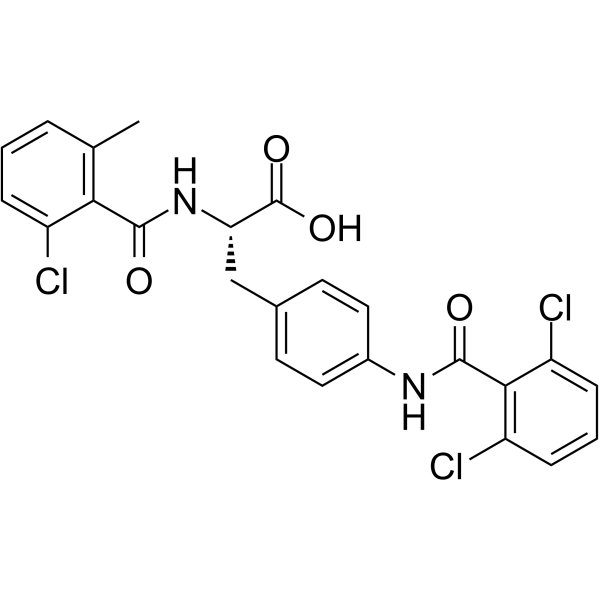Physicochemical Properties
| Molecular Formula | C24H19CL3N2O4 |
| Molecular Weight | 505.78 |
| Exact Mass | 504.041 |
| CAS # | 220846-33-3 |
| PubChem CID | 16727128 |
| Appearance | Off-white to light yellow solid powder |
| LogP | 6.097 |
| Hydrogen Bond Donor Count | 3 |
| Hydrogen Bond Acceptor Count | 4 |
| Rotatable Bond Count | 7 |
| Heavy Atom Count | 33 |
| Complexity | 691 |
| Defined Atom Stereocenter Count | 1 |
| SMILES | CC1=C(C(=CC=C1)Cl)C(=O)N[C@@H](CC2=CC=C(C=C2)NC(=O)C3=C(C=CC=C3Cl)Cl)C(=O)O |
| InChi Key | JTVWJXUGGJTGDA-IBGZPJMESA-N |
| InChi Code | InChI=1S/C24H19Cl3N2O4/c1-13-4-2-5-16(25)20(13)22(30)29-19(24(32)33)12-14-8-10-15(11-9-14)28-23(31)21-17(26)6-3-7-18(21)27/h2-11,19H,12H2,1H3,(H,28,31)(H,29,30)(H,32,33)/t19-/m0/s1 |
| Chemical Name | (2S)-2-[(2-chloro-6-methylbenzoyl)amino]-3-[4-[(2,6-dichlorobenzoyl)amino]phenyl]propanoic acid |
| HS Tariff Code | 2934.99.9001 |
| Storage |
Powder-20°C 3 years 4°C 2 years In solvent -80°C 6 months -20°C 1 month |
| Shipping Condition | Room temperature (This product is stable at ambient temperature for a few days during ordinary shipping and time spent in Customs) |
Biological Activity
| Targets | α4β1 α4β7 |
| ln Vitro | At 33 nM, RO0270608 inhibits cell adhesion mediated by α4/β7. In an experiment for human T-cell VCAM/anti CD3 costimulation, RO0270608 significantly inhibits T-cell proliferation (IC50=30 nM)[2]. |
| ln Vivo | RO0270608 eliminates allergen-induced inflammatory cell accumulation in a mouse OVA-model of airway inflammation[2]. |
| References |
[1]. Pharmacokinetics, safety, and tolerability of R411, a dual alpha4beta1-alpha4beta7 integrin antagonist after oral administration at single and multiple once-daily ascending doses in healthy volunteers. J Clin Pharmacol. 2004;44(12):1368-1. [2]. Dual α4/β1–α4/β7 vs α4/β1 selective antagonism is required for attenuation of allergic inflammatory responses. Journal of Allergy and Clinical Immunology. Volume 113, Issue 2, Supplement, February 2004, Page S221. |
Solubility Data
| Solubility (In Vitro) | DMSO : 12.5 mg/mL (24.71 mM) |
| Solubility (In Vivo) |
Solubility in Formulation 1: ≥ 1.25 mg/mL (2.47 mM) (saturation unknown) in 10% DMSO + 40% PEG300 + 5% Tween80 + 45% Saline (add these co-solvents sequentially from left to right, and one by one), clear solution. For example, if 1 mL of working solution is to be prepared, you can add 100 μL of 12.5 mg/mL clear DMSO stock solution to 400 μL PEG300 and mix evenly; then add 50 μL Tween-80 to the above solution and mix evenly; then add 450 μL normal saline to adjust the volume to 1 mL. Preparation of saline: Dissolve 0.9 g of sodium chloride in 100 mL ddH₂ O to obtain a clear solution. Solubility in Formulation 2: ≥ 1.25 mg/mL (2.47 mM) (saturation unknown) in 10% DMSO + 90% (20% SBE-β-CD in Saline) (add these co-solvents sequentially from left to right, and one by one), clear solution. For example, if 1 mL of working solution is to be prepared, you can add 100 μL of 12.5 mg/mL clear DMSO stock solution to 900 μL of 20% SBE-β-CD physiological saline solution and mix evenly. Preparation of 20% SBE-β-CD in Saline (4°C,1 week): Dissolve 2 g SBE-β-CD in 10 mL saline to obtain a clear solution. Solubility in Formulation 3: ≥ 1.25 mg/mL (2.47 mM) (saturation unknown) in 10% DMSO + 90% Corn Oil (add these co-solvents sequentially from left to right, and one by one), clear solution. For example, if 1 mL of working solution is to be prepared, you can add 100 μL of 12.5 mg/mL clear DMSO stock solution to 900 μL of corn oil and mix evenly. (Please use freshly prepared in vivo formulations for optimal results.) |
| Preparing Stock Solutions | 1 mg | 5 mg | 10 mg | |
| 1 mM | 1.9771 mL | 9.8857 mL | 19.7714 mL | |
| 5 mM | 0.3954 mL | 1.9771 mL | 3.9543 mL | |
| 10 mM | 0.1977 mL | 0.9886 mL | 1.9771 mL |
